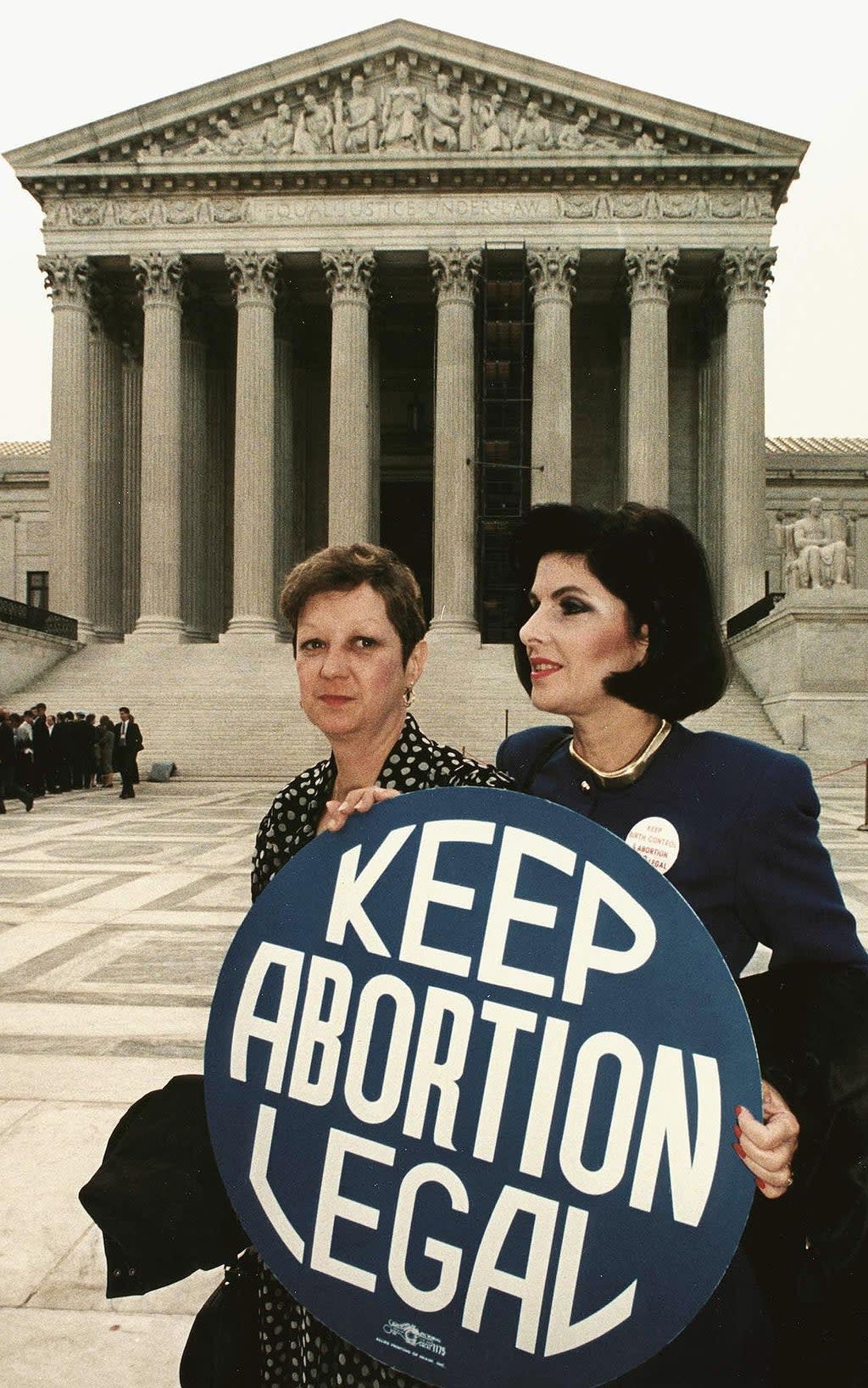What is Roe v Wade and did it get overturned?

- Oops!Something went wrong.Please try again later.
- Oops!Something went wrong.Please try again later.
The landmark ruling enshrining abortion rights in the US is back in the spotlight as the US Supreme Court reviews a Mississippi law banning most abortions after 15 weeks, potentially igniting a major challenge.
It marks the first major abortion rights challenge in front of the three newest justices, all conservatives appointed by Donald Trump. The Supreme Court heard oral arguments in the case on 1 December.
The 1973 ruling is considered the first successful litmus test protecting a pregnant woman’s right to have an abortion in the US, legalising the procedure across the country and setting a global precedent.
The ruling repealed many federal and state abortion laws that restricted access for women or banned the procedure outright and sparked decades of religious and moral conflict, fought over women’s bodies.
What is Roe v Wade?
The case revolved around Norma McCorvey – known for the purposes of the proceedings as “Jane Roe” – who became pregnant with her third child in Texas in 1969 and wanted to have an abortion, but was unable to access one due to it being banned in her state in all cases but to “save a woman’s life.”
She was taken on by lawyers Sarah Weddington and Linda Coffee, who filed a lawsuit on her behalf in US federal court against her local district attorney, Henry Wade, alleging that Texas’s abortion laws were unconstitutional.
The US District Court for the Northern District of Texas ruled in her favour, which was kicked up to the Supreme Court after Texas appealed.
The Supreme Court’s 7-2 decision in Ms McCorvey’s favour was based partly on the Constitutional “right to privacy”, which the judges found covered a woman’s right to access abortion.
Ms McCorvey, who was unable to access a legal abortion, gave birth before the case was heard and the baby was put up for adoption.
She said at the time that she did it “on behalf of herself and all other women” in the same situation.
The decision also set a legal precedent that affected more than 30 subsequent Supreme Court cases involving restrictions on access to abortion.
The American rights has committed for decades to overturning Roe. The most recent addition to the Supreme Court, Amy Coney Barrett, brought the high court’s conservative balance to six against three. Mr Trump appointed two other conservative judges, Neil Gorsuch and Brett Kavanaugh.
Is Roe v Wade constitutional?
Abortion is constitutionally protected healthcare unless the Supreme Court overturns precedent established by Roe.
On 20 January, the high court declined abortion providers’ request to intervene in an ongoing legal challenges to a Texas law banning most abortions at six weeks or pregnancy – including in cases of rape and incest – that has abortion rights advocates concerned that Roe v Wade could be overturned at the federal level.
That case is pending before the 5th Circuit Court of Appeals. Abortion rights advocates hoped that the Supreme Court would direct the case to federal district court, where a previous ruling had blocked the law.
Abortion rights proponents fear that the Supreme Court’s refusal to intervene indicates a willingness in the judicial body to consider a full repeal of the law in a future challenge.
What did Roe v Wade establish?
The ruling from Roe v Wade established federal protections for women who wish to have an abortion.
The decision ultimately gave women total autonomy to terminate a pregnancy during the first trimester, and allowed some state influence over abortions in the second and third trimesters.
The court’s opinion in Roe v Wade established that choosing to have an abortion is ultimately an issue of Americans’ right to privacy, which they ruled was an element of the liberty guaranteed by the US Constitution.
The court determined that banning abortions would infringe on women’s right to privacy, and that being forced to have an unwanted child could “force upon the woman a distressful life and future.”
That right to privacy is not absolute though, and the court established the differences in abortion rights based on trimesters to assure states could maintain medical standards and safeguard health.
Then as now, advocates opposing abortion attempted to argue that life begins at conception. The court disagrees, ultimately saying that the US Constitution’s use of “person” in establishing inalienable rights did not represent fetuses.
Was Roe v Wade overturned?
Roe v Wade has not been overturned.
Some reactions to the court’s refusal to block an abortion ban in Texas have incorrectly claimed that the law was overturned.
Ultimately the argument is one of semantics. Those arguing that Roe v Wade has been overturned operate from the perspective that if the Supreme Court is unwilling to block an abortion ban in Texas, it is safe to assume the court would take the same action for any other state seeking to ban abortion with similar laws.
However, until the high court reaches a decision, Roe v Wade is still the law of the land.
If the Supreme Court upholds a decision in Texas, then Roe v Wade – while not officially overturned – will only provide protection for women’s rights to abortion until individual states enact their own abortion bans.
The semantic difference will make little difference for women living in states that decide to pursue bans similar to Texas’s. Even if the Supreme Court only refuses to block bans while they are being litigated, it will still mean women in those states will be unable to access abortions for months or years before the laws are settled and challenged.

